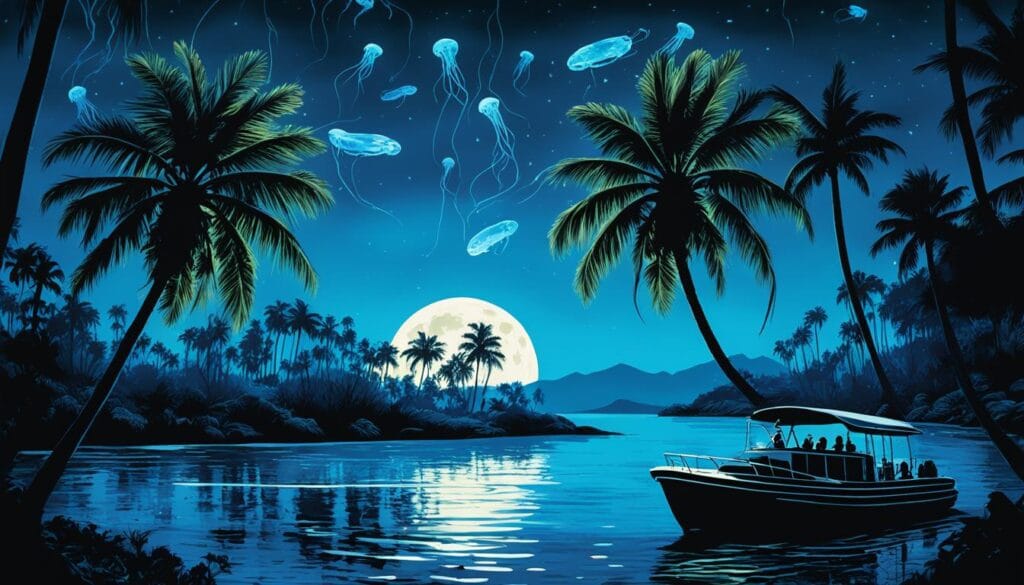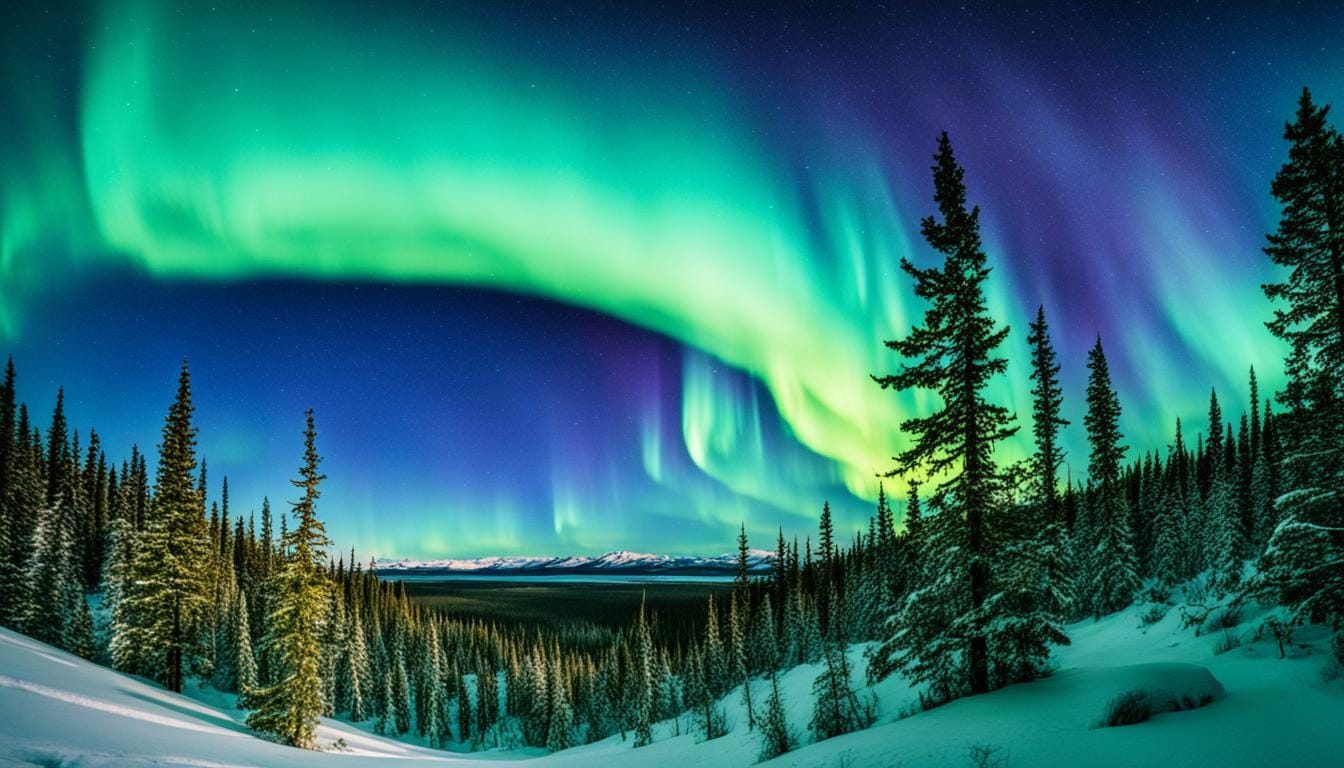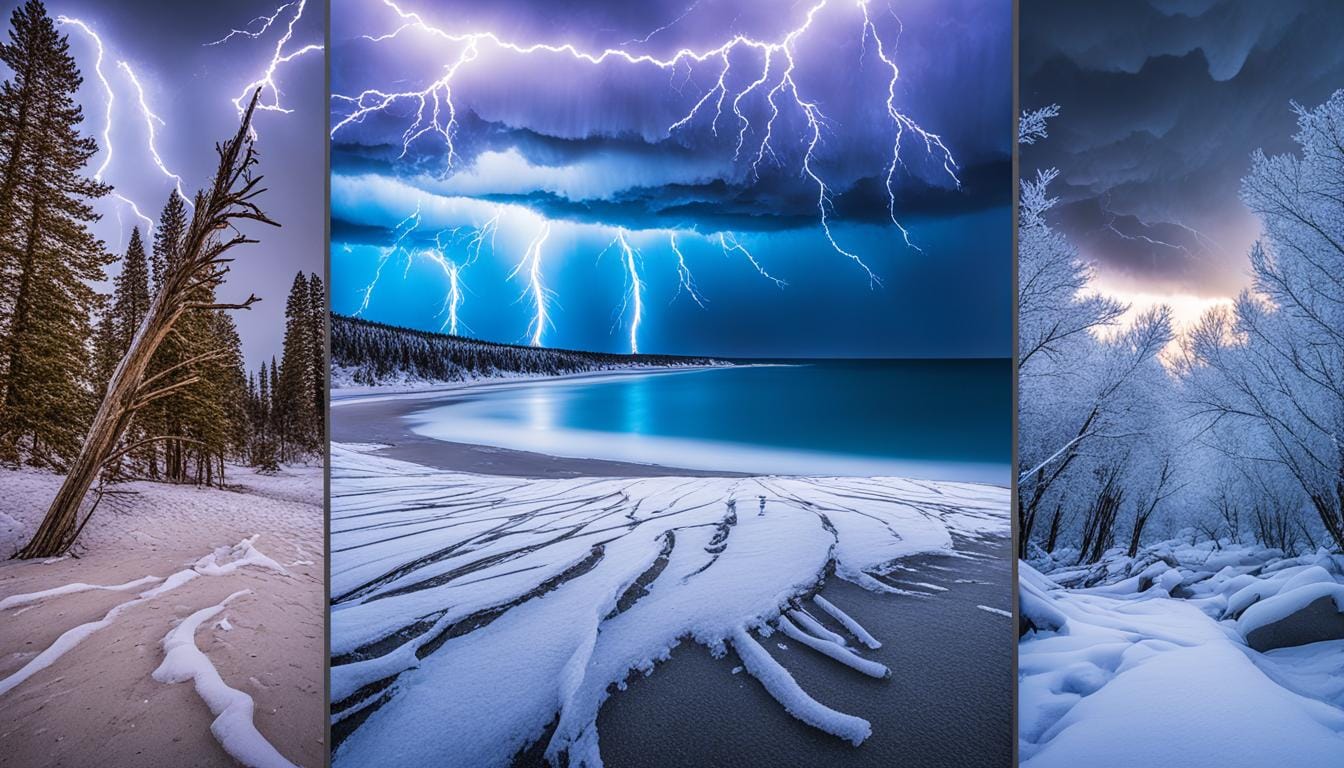Bioluminescent bays, or “bio bays,” are special waters filled with tiny creatures called dinoflagellates. These tiny beings light up the water with a bright blue-green glow. When something moves in the water, it looks like the sea is alive with light.
There are only five bioluminescent bays in the whole world. They are rare and truly magical. Visitors get to see nature’s light show up close, making it an unforgettable experience.
Imagine paddling through glowing waters, where your kayak or a splash makes the water light up. This magical sight is only found in a few places worldwide. Puerto Rico has three of these amazing spots.
The Enchantment of Bioluminescence
Bioluminescence is a magical way that living things make their own light. It’s what makes the lights in bioluminescent bays so captivating. These lights come from tiny marine plankton called dinoflagellates. They have a special light-producing pigment inside them that lights up when they move.
Microscopic Organisms that Produce Light
The glow in bioluminescent bays happens because of a special chemical reaction in the dinoflagellates. When the water moves, like when a kayak goes by, these tiny creatures light up with a bright, electric-blue glow. This amazing light show is a sight to see, bringing people from all over to experience it.
A Natural Defense Mechanism
The glow of the dinoflagellates is also a way to protect themselves. It confuses predators and helps them catch food. This special trick lets these tiny creatures live well in the ocean, making the bioluminescent bays vibrant and healthy.

Bioluminescent Bays in Puerto Rico
Puerto Rico has three of the world’s five bioluminescent bays. Each one offers a unique and captivating light show. From the bright Mosquito Bay on Vieques Island to the calm Laguna Grande in Fajardo, these places show off Puerto Rico’s bioluminescent wonders.
Mosquito Bay on Vieques Island
Mosquito Bay on Vieques Island is the brightest bioluminescent bay in the world. It has a huge number of dinoflagellates, from 1,000,000 to 2,100,000 per gallon of water. This creates a beautiful glow in the turquoise waters, amazing those who see it.
Laguna Grande in Fajardo
Laguna Grande is in the town of Fajardo, near San Juan. It’s the most visited bioluminescent bay in Puerto Rico. People come from all over to see the bay’s glowing waters up close.
La Parguera in Lajas
La Parguera is in Puerto Rico’s southwest. It’s the only place where you can swim in a bioluminescent bay. Tours let visitors dive in and swim in the glowing waters.

The Science Behind the Glow
The glowing lights in the bay come from a special chemical reaction. At the center of this are tiny creatures called dinoflagellates. These small plankton can make light through a thing called bioluminescence.
This glow happens when a molecule in the dinoflagellates, called luciferin, meets an enzyme called luciferase with oxygen around. This mix makes a blue-green light without any heat. It’s a very efficient way for nature to light up.
There are about 70 types of dinoflagellates that can make light. Each type has its own special luciferin, making different colors of light. But, the most common color in bioluminescent bays is a beautiful blue-green. This color travels the farthest in water.
In some bays, there can be up to a million dinoflagellates per gallon. This creates a stunning “fairy lights” effect when the water moves. Mosquito Bay in Vieques Island, Puerto Rico, is the brightest bioluminescent bay in the world. It’s full of light-producing plankton.
| Location | Dinoflagellate Concentration | Brightness Level |
|---|---|---|
| Mosquito Bay, Vieques Island, Puerto Rico | Highest | Guinness World Record Holder |
| Laguna Grande, Fajardo, Puerto Rico | High | Brightest on Puerto Rico’s Main Island |
| La Parguera, Lajas, Puerto Rico | Lower | Less Bright than other Bays |
The bioluminescent bays need the right conditions to work well. They need warmth, the right salt level, and enough food. Things like storms or changes in the wind and water can affect the dinoflagellates. This can make the glow brighter or dimmer.
Kayaking Through Glowing Waters
Exploring Puerto Rico’s bioluminescent bays is an experience you won’t forget. Kayaking is a top way to dive into this natural wonder. As you move your kayak, it stirs the dinoflagellates, making them light up the water with a magical glow. Many tours in the area let you see this amazing sight up close.
Guided Tours and Experiences
Guided kayaking tours are a favorite way to see bioluminescent bays. These tours last 1.5 to 3 hours and cost $60 to $85 per person. Some tours use glass-bottom kayaks, so you can see the glowing plankton below. Summer is the best time to go, when the water is warm and the plankton is active.
Booking your tour around the new moon increases your chances of seeing the glow. This is when the sky is darkest and the bioluminescence shines brightest.
Some companies also offer bioluminescent rafting. You float on a group raft through the glowing waters. These 1.5-hour trips cost about $60 and give a different view of the glowing waters.
Choosing a kayaking or rafting tour with a guide is the best way to enjoy the glowing waters. With the right tour and timing, you’re set for an adventure you’ll always remember.
Bioluminescent Bays Around the World
While Puerto Rico’s bioluminescent bays are famous, they’re not the only ones. Places like the Waitomo Caves in New Zealand and the Toyama Bay in Japan also have these natural light shows. These spots are perfect for those who love adventure and nature.
Jamaica’s Glistening Waters, also known as the Luminous Lagoon, is a must-see. It’s filled with tiny bioluminescent microorganisms. When disturbed, they light up the water, creating a magical scene.
The Maldives is home to beautiful bioluminescent beaches. Vaadhoo Island is famous for its glowing shores, called the “Sea of Stars”. This happens because of tiny phytoplankton that glow blue when the waves hit the shore.
Other places to see bioluminescence include the Waitomo Caves in New Zealand and the Gippsland Lakes in Australia. In these spots, you can see glowworms and glowing water, respectively.
In Japan, Toyama Bay is known for its bright blue lights. These come from firefly squids with special light organs. Halong Bay in Vietnam also shows off its bioluminescence with glowing waters and limestone cliffs.
| Destination | Bioluminescent Phenomenon |
|---|---|
| Jamaica | Glistening Waters (Luminous Lagoon) |
| Maldives | Vaadhoo Island (“Sea of Stars”) |
| New Zealand | Waitomo Caves (Glowworms) |
| Australia | Gippsland Lakes |
| Japan | Toyama Bay (Firefly Squids) |
| Vietnam | Halong Bay |
From the Caribbean to the Far East, these bioluminescent bays are truly special. They offer a unique experience for those who love nature and adventure. Whether it’s the glowing waters of Jamaica, the “Sea of Stars” in the Maldives, or the glow of the Waitomo Caves, these places are unforgettable.
Preserving Nature’s Light Shows
The bioluminescent bays of the world are amazing natural sights. They show off glowing waters that amaze everyone. But, these special places are easily hurt by pollution, development, and climate change. We need to work together to keep the magic of bioluminescence alive.
Conservation Efforts and Sustainable Practices
Keeping bioluminescent bays safe is a big task. Conservation efforts aim to cut down on pollution and environmental impacts. This helps protect the tiny creatures and marine life that light up the water. We need to control activities that could hurt the water, like limiting boat traffic and managing waste well.
It’s also key to support sustainable tourism. Things like guided kayak tours and educational programs teach people and reduce our impact. By joining forces, locals, policymakers, and visitors can help keep these natural wonders safe for the future.
The bioluminescent bays are incredible, but they’re not safe forever. With strong environmental protection and sustainable tourism, we can save these magical light shows. By fighting pollution and development impacts, we can keep the magic of bioluminescence alive for others to enjoy.
The Best Times to Visit Bioluminescent Bays
Planning your visit to bioluminescent bays can make the experience even more magical. The best time to see these natural light shows varies by location and conditions.
The dry season, from December to mid-April, is usually the best time to visit. This period has clear water and bright bioluminescent displays. The rainy season, from June to November, can make the water cloudy and reduce the glow.
The full moon also plays a big role. While you can see bioluminescence all year, it’s usually brighter during the new moon. This is because the night sky is darker, making the glow stand out more.
Other factors like tide, temperature, and natural disasters can change how bright the bioluminescent bays are. It’s a good idea to check the specific conditions and best times to visit your chosen bay. This way, you can have the best experience possible.
| Location | Best Time to Visit | Brightness Level |
|---|---|---|
| Mosquito Bay, Vieques Island, Puerto Rico | Year-round, with peak visibility from December to May | Considered the brightest bioluminescent bay in the world |
| Laguna Grande, Fajardo, Puerto Rico | December to May, with the brightest displays during the new moon | Offers a glowing blue appearance at night |
| La Parguera, Lajas, Puerto Rico | December to May, with the best visibility during the new moon | Slightly less bright than Mosquito Bay and Laguna Grande |
Knowing the best times to visit bioluminescent bays helps travelers plan for the best conditions. This way, they can have an unforgettable experience with nature’s light shows.
Bioluminescent Plankton Concentrations
Mosquito Bay in Puerto Rico is famous for its glowing plankton. It has the Pyrodinium bahamense dinoflagellate, which can reach up to 700,000 per gallon of water. This is one of the highest levels of glowing life on Earth.
This high plankton count makes Mosquito Bay the brightest glowing bay in the world. It’s even in the Guinness World Records. The many glowing microorganisms create a stunning light show. This attracts visitors from all over to see this natural wonder.
Record-Breaking Levels in Mosquito Bay
Mosquito Bay has the most glowing plankton, much more than other famous places. For instance, the Luminous Lagoon in Jamaica is bright, but not as bright as Mosquito Bay.
Puerto Rico has three glowing bays, but Mosquito Bay has the most glowing plankton. It’s the top spot for glowing plankton in the world.
The glowing display in Mosquito Bay shows how amazing these tiny creatures are. They can light up the water so brightly. It’s a natural light show that amazes everyone who sees it.
Responsible Tourism in Bioluminescent Bays
The bioluminescent bays of Puerto Rico are amazing natural sights. They attract visitors from all over the world. But, these places are very sensitive to changes and human actions. It’s important to visit them responsibly to keep them safe for the future.
When visiting these bays, follow the rules given by local authorities and tour guides. Don’t use artificial lights to avoid disturbing the glow. Also, don’t do anything that could harm the water or the tiny creatures that make the bay glow.
Supporting conservation and sustainable tourism helps protect these bioluminescent bays. Local people and tour operators teach visitors about the importance of taking care of the environment. They encourage visitors to be good stewards of these natural wonders.
Responsible tourism lets us enjoy the beauty of bioluminescent bays while keeping them safe. By working together, we can make sure these natural light shows are here for future visitors to see.
| Location | Dinoflagellate Concentration | Visitor Restrictions |
|---|---|---|
| Mosquito Bay, Vieques | 1,000,000 – 2,100,000 per gallon | No swimming allowed |
| Laguna Grande, Fajardo | N/A | Kayaking only, no swimming |
| La Parguera, Lajas | N/A | Swimming allowed |
By being responsible tourists and supporting conservation, we can keep these bioluminescent bays safe. Let’s help protect their beauty for the future.
Year-Round Bioluminescence
Some bioluminescent hotspots shine all year, like Mosquito Bay in Puerto Rico. These places have the right mix of water temperature, nutrients, and little light pollution. This lets the bioluminescent plankton glow brightly all year.
Mosquito Bay on Vieques Island, Puerto Rico, is the brightest bioluminescent bay. It has up to 700,000 dinoflagellates per gallon of seawater. These tiny creatures light up the water with a blue-green glow for just a second.
The Indian River Lagoon in Central Florida also lights up all year. The best times to see dinoflagellates are from June to October. From December to late spring, you can see comb jellies lighting up the water.
National Geographic calls Florida’s Space Coast a top spot for bioluminescence. This means you can enjoy these glowing waters any season. It’s a special way to connect with nature and its wonders.
Bioluminescent Bays: A Natural Wonder
Bioluminescent bays show us the amazing beauty of nature. They let us see how marine life has adapted in incredible ways. These special waters glow because of tiny creatures that live there.
In Puerto Rico, you can find three famous bioluminescent bays. Mosquito Bay in Vieques, La Parguera in Lajas, and Laguna Grande in Fajardo are the names. Mosquito Bay is known as the brightest, with millions of tiny creatures per gallon of water.
The glow comes from dinoflagellates, tiny plankton-like beings. They light up blue-green when moved. The best time to see this is during a new moon, when it’s darkest.
Visitors can kayak or boat through the glowing waters. It’s a chance to see nature’s beauty up close. These places show us how important marine life and ecosystems are.
It’s important to keep these bays safe. They are delicate and can be harmed by us. We need to keep the water clean, protect the mangroves, and support eco-friendly tourism. This way, these wonders can keep amazing people for years to come.
Conclusion
The bioluminescent bays of Puerto Rico and beyond are truly amazing. They fill us with awe and wonder. These places show how marine life has adapted and how our planet’s environments work together.
We must keep exploring and enjoying these bioluminescent bays. But, we also need to focus on saving them for the future. This means we must work on conservation and sustainable tourism.
By working together, we can protect these glowing natural wonders and the marine life they support. We can fight against pollution and climate change. This way, these bioluminescent bays can stay bright and full of life for a long time.
Let’s think about the beauty of these bioluminescent bays and what we can do to help. With hard work and caring for the environment, we can keep their magic alive. We can make sure these glowing ecosystems continue to amaze and inspire everyone who sees them.


